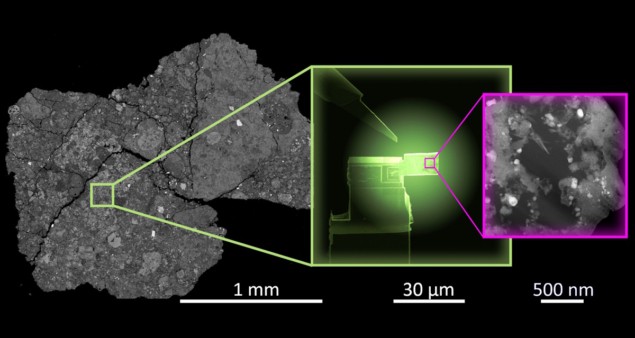
The meteorite that fell on a Gloucestershire driveway in 2021 contained amino acids and nucleobases that could be precursors to the chemical building blocks of life on Earth, according to analysis using a new electron microscopy technique.
On the evening of 28 February 2021, a bright fireball was witnessed streaking through the sky over south-west England. Fragments of the meteorite were recovered from the Gloucestershire village of Winchcombe the next day – precious interplanetary treasure from the first recorded meteorite fall in the UK since 1991.
Now, analysis of the meteorite with the scanning transmission electron microscope (STEM) at the National Research Facility for Advanced Electron Microscopy – better known as SuperSTEM – in Daresbury, UK, has identified amino acids and N-heterocycles. The latter are nitrogen-bearing compounds that form simple nucleobases. While none of these compounds are directly part of life’s chemistry, they could be precursors for biologically relevant amino acids and the more complex nucleobases utilized by RNA and DNA.
Terrestrial weathering and biological contamination can alter a meteorite’s chemical composition, a complication that afflicts most meteorites that are not found until days, months or years after their landfall. In contrast, the Winchcombe meteorite was recovered within 12 hours.
“The fast retrieval definitely helped to detect these compounds,” says Christian Vollmer of the Institute of Mineralogy at Münster University in Germany, who led the study. “The pristine nature of the Winchcombe meteorite was crucial for our work, because this limited the effect of terrestrial alteration and nitrogen-bearing compounds are very prone to alteration and dissolution.”
Super electron microscopy
The concentrations of these organic compounds within the meteorite are low, but they were enough to be discovered by the powerful electron microscope at SuperSTEM.
Since the early 2000s, SuperSTEM’s mission has been to test new technology and techniques in the field of electron microscopes. “The best way to describe it is as the ‘Skunk Works’ for electron microscopy,” says SuperSTEM’s director, Quentin Ramasse of the University of Leeds.
Electron microscopes work by scanning a nanoscale target with a beam of electrons to build up a picture. The analysis of the Winchcombe meteorite added a new technique not dissimilar to absorption spectroscopy. As the electrons impact the meteorite they are slowed down or shift wavelength in response to the meteorite’s composition.
“We see a difference in the spectroscopy signal depending on the specific molecule,” Ramasse tells Physics World.
This electron spectroscopy method is far less invasive than traditional analysis techniques that rely on chemical separation, which can damage the precious sample.
“Usually such compounds have to be extracted from meteorites by solvents and complex chemical extraction procedures,” says Vollmer. “In our work, it was possible to detect these compounds – tentatively – without using any chemical separation or concentration, in a dedicated electron microscope.”
Cosmic connection
The amino acids and N-heterocycles identified in the Winchcombe meteorite are like those compounds found in other meteorites, providing further support for the theory that the building blocks for life on Earth came from space. Ramasse hopes that the study of the Winchcombe meteorite can be taken even further by SuperSTEM, by exploring isotopic ratios to determine where and when the meteorite formed in the pre-solar nebula that became the solar system 4.6 billion years ago.
“Areas that have a specific isotopic ratio might be more pristine and have formed earlier than areas that have a ratio more similar to what we find on Earth today,” Ramasse explains. Key ratios include those between carbon-12 and -13 atoms, and nitrogen-14 and -15.
“One of the things we’d like to do is look for those hotspots and coldspots where there’s more nitrogen-15 or less nitrogen-15, and see how the functional chemistry varies and backtrack to different points in the solar system’s history,” says Ramasse.

Meteorites and magnetostrophic mathematics reveal unsung scientific heroes of the past
And it’s not just meteorites that the SuperSTEM researchers hope to get their hands on. We’re increasingly in the age of sample-return missions, with rocks brought back to Earth from asteroids by the Japanese Hayabusa2 mission and NASA’s OSIRIS-REx, as well as samples from the Moon and even, with a little luck, from Mars in the early 2030s.
“We were lucky to look at Winchcombe because it fell in the UK and therefore is curated by the Natural History Museum [in London],” says Ramasse. “But getting our hands on samples from Hayabusa2 and OSIRIS-REx would also be very exciting.”
The findings from the Winchcombe meteorite are described in Nature Communications.
- SEO Powered Content & PR Distribution. Get Amplified Today.
- PlatoData.Network Vertical Generative Ai. Empower Yourself. Access Here.
- PlatoAiStream. Web3 Intelligence. Knowledge Amplified. Access Here.
- PlatoESG. Carbon, CleanTech, Energy, Environment, Solar, Waste Management. Access Here.
- PlatoHealth. Biotech and Clinical Trials Intelligence. Access Here.
- Source: https://physicsworld.com/a/advanced-electron-microscope-finds-uk-meteorite-fall-contains-lifes-chemical-precursors/



